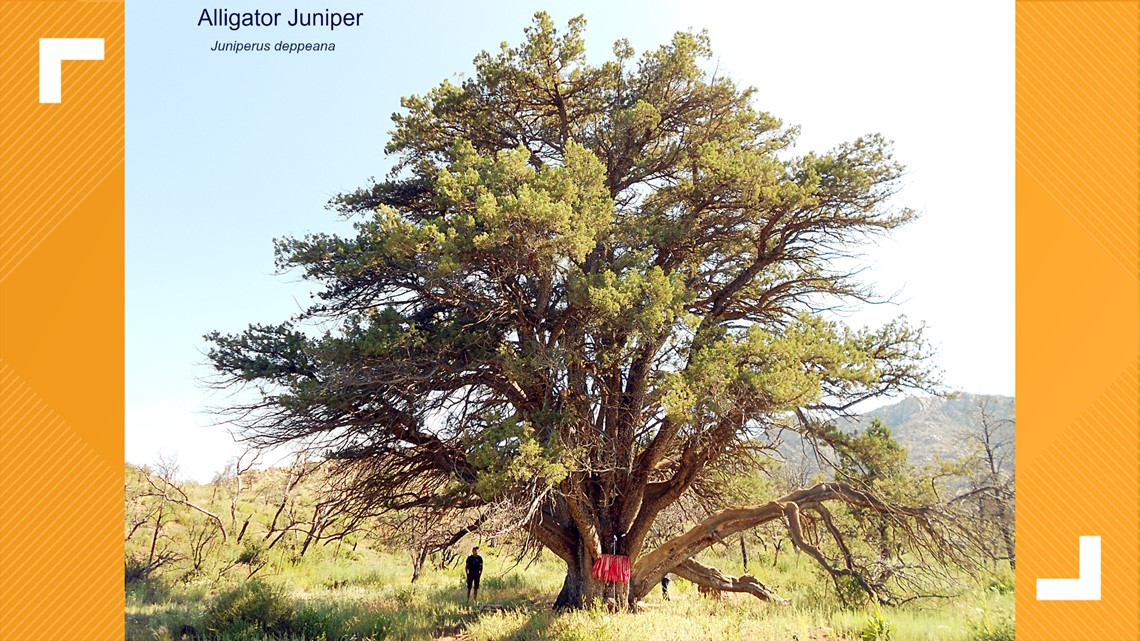PRESCOTT, Ariz. — The trail is unmarked, but the history is unmistakable. Flames coursed through here nearly a decade ago. But what's left behind tells the story.
Two stories.
The trail in the Prescott National Forest holds two pieces of state history: one, a towering example of how large life can be, and another, a tragedy on how easily life can be taken away.
It guides travelers through still-blackened desert grasses and bushes toward a massive tree and a plaque that reads "ESSE QUAM VIDERI."
The Latin phrase translates as "to be, rather than to seem."
It's not just another hiking trail. It's actually the site of both Arizona's most famous tree and where a group of firefighters was tasked with fighting an inferno spanning thousands of acres.
The wildfire would be the last successful operation of the Granite Mountain Hotshots before 19 died in a wildfire a week later on June 30.
"This giant was standing amongst the scorched landscape"
The species of the historic tree standing at the end of the trail is the namesake of the trail itself: alligator juniper.
The tree, estimated to be the world's largest alligator juniper, was saved from the 2013 Doce Fire by the Granite Mountain Hotshots, a crew of 20 wildland firefighters.
"[The hotshots] cleared brush, dug fire line and burned the fuels around this alligator juniper before the main fire could destroy it," a plaque on the trail commemorating the event reads. "Upon their return after the fire had passed, this giant was standing amongst the scorched landscape."
The Doce Fire burned nearly 7,000 acres of the Prescott National Forest. However, it didn't burn any nearby homes or structures thanks to the efforts of hundreds of responding firefighters, including the hotshot crew.
The battle to save the tree from the Doce Fire was shown in the 2013 movie "Only the Brave," a biographical drama detailing the lives and heroic efforts of the hotshots.
The film also shows a version of the tragedy that happened a week after the hotshots stopped the Doce Fire, when 19 of the hotshots were cut off by the Yarnell Hill Fire and died when they were overrun by flames.
Thursday marks the 9-year anniversary of the tragedy.
See a clip of the alligator juniper rescue scene from the movie here:
Arizona's oldest living icon...maybe
The alligator juniper isn't only famous for being the largest of its species in the world or for being saved by the iconic hotshots. The tree might also be the state's oldest living icon.
The age of the tree differs between local folklore and scientific research.
One of the firefighter actors can be heard saying the "national treasure" tree is over 2,000 years old in the above movie clip. The belief has been anecdotally shared among locals and appears in multiple results when searching the term on Google.
The tree's true age still towers above the usual lifespans living things are accustomed to, according to researchers.
"The documentation that we have on file on this tree is that, in 1998 when it was submitted, they estimated the age to be about 1,400 years old," said LoriAnne Warren, an urban forestry specialist at the Arizona Department of Forestry and Fire Management.
"Typically trees don't live that long, and definitely not in an urban environment. You'd be lucky if you got a 50-year lifespan."


Christopher Baisan, a senior researcher at the University of Arizona's Tree Ring Lab, said the tree may be around 1,000 years old, but added that finding an exact age for an alligator juniper is extremely difficult to do.
"You can't determine an accurate age by our usual methods of counting annual rings," Baisan said. "[Alligator juniper] trees live in dry sites and when they run out of moisture, they just stop growing. When monsoon storms come, they could gain multiple rings in a single year. There's no way to accurately measure them."
While Baisan thinks other trees may rival the alligator juniper for the title of "Arizona's oldest living tree," such as a bristlecone pine in the San Francisco Peaks, it shouldn't diminish the importance of the tree nor the awe it inspires.
A "Champion" among magnificent trees
Arizona has a "Magnificent Tree Program" run through the forestry and fire management department that catalogs important tress from around the state for numerous reasons, including:
- Champion trees, or trees that are the largest of their species
- Heritage trees, or trees that have a direct cultural connection to people
- Witness trees, or trees that are proven to be in the same location prior to Arizona statehood
The alligator juniper is officially designated as a champion tree, but could also be considered a heritage tree for more than one reason.
"This alligator juniper is a great example of storytelling and legend, not only because of the firefighters that saved it, but because of how the tree has been a cornerstone in that community a long time before the fire happened," Warren said.
Warren sees how the tree has spurred folklore in the nearby human community, but also wanted to emphasize the role the tree plays in its ecological community.
The berries of the tree provide a food source to birds while the canopy cover offers protection from predators. Bees and other insects have been known to create hives in the tree's bark while fungi on the tree's roots fertilize the surrounding soil.
"Think about how much this tree has seen in ecology in the last thousand years. It's mind-blowing. You can't get your head around something that lives that long," Warren said.
Have a "magnificent tree" you'd like to nominate for the Arizona program? Fill out this nomination form for a chance to have your favorite tree receive designation.
Check out the top 25 magnificent trees across Arizona here:
We ❤ Arizona
Explore amAZing people, places and things across our state on our 12 News YouTube playlist here.

